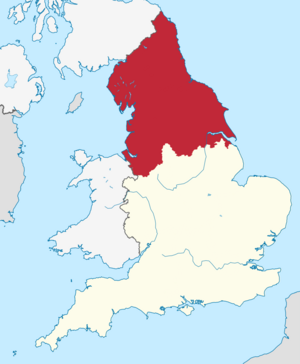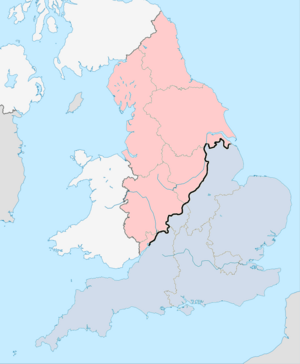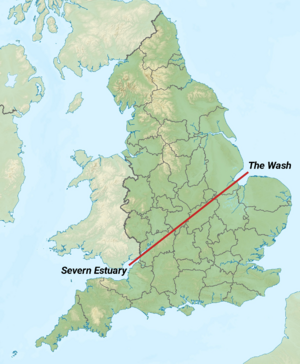North–South divide in England facts for kids

In England, the North–South divide describes the differences between two main areas: Southern England and Northern England. These differences can be seen in culture, economy, and social life.
- Southern England usually includes South East England, South West England, Greater London, and the East of England.
- Northern England typically refers to North East England, Yorkshire and the Humber, and North West England. This includes big cities like Liverpool and Manchester.
There's also the central region called the Midlands. Historically, this area was part of the Kingdom of Mercia. Some northern parts of the Midlands, like Derbyshire and Nottinghamshire, are sometimes seen as part of the North.
The differences between the North and South also show up in English politics. For many years, the Labour Party was very strong in the North. The Conservative Party was more popular in the South. However, in the 2019 election, many northern areas voted for the Conservatives. This was partly due to Brexit. Some experts say this election changed how people vote in England.
In 2012, The Economist magazine suggested that the gap between the North and South was growing. They said it was like they were almost separate countries. This was based on things like how long people live, political views, and economic trends.
Contents
What is the North-South Divide?
The North–South divide isn't a straight line on a map. Instead, it's about different ideas and feelings people have about these regions. Experts often debate how big these differences really are. For example, some reports show that the South of England has faster economic growth. Other reports say the difference is very small. It depends on what information you look at.
Generally, here are some ways the North and South often differ:
- Health: People in the North tend to have more health problems. However, more money is spent on healthcare there.
- House Prices: Homes are much more expensive in the South, especially around London.
- Earnings: People in the South and East generally earn more money.
- Political Power: The South often has more influence in government.
- Public Investment: London and the South-East received 50% more public money per person than the North in the five years up to 2019–20.
However, if you consider things like the cost of living or poverty in cities, the differences can be less clear.
Also, some areas in the North are very wealthy. For example, towns near Leeds and Manchester like Harrogate and Alderley Edge are quite rich. On the other hand, some areas in the South, like the Isle of Thanet in Kent, have faced economic problems. Other southern places like Cornwall and parts of London also have health and education challenges.
Some people think that other things, like social class or background, might be more important than just North or South.
One reason for the divide, according to The Economist, is that many young professionals move from the North to work in London. It's less common for people from the South to move to northern cities for work.
A report in 2019 suggested that the UK has bigger regional differences than most other developed countries. This report blamed the problem on power being too centralised in London.
In 2020, the Northern Independence Party was formed. Its goal is to make the North of England independent to help fix the North-South divide.
Cultural Differences
Culture and Identity
There are also cultural differences between the North and South. A TV series called It's Grim Up North explored these differences. People in the North sometimes felt they had fewer cultural opportunities. The show also suggested that life in the South could feel less personal.
When Granada Television started broadcasting in 1956, it was based in Manchester. Their slogan was "From The North, Granada Presents...". This showed their strong northern identity.
Not all TV shows follow the stereotype of a rich South and poor North. Shows like Cold Feet feature wealthy people from the North. Meanwhile, Only Fools and Horses shows working-class life in Peckham, a southern area.
Some statistics suggest that people in the North of England eat more fast food. Many of the UK's "fattest cities" are in the North or West.
Language and Dialect
Even though younger people might not use very specific local accents, there's still a clear difference between northern and southern speech. Young Northerners often try to keep their northern accent rather than sounding southern.
Sometimes, these accent differences are used for comedy. But there's a serious side too. Some people believe the London media looks down on northern English accents. For example, Ken Livingstone once suggested that John Prescott was treated unfairly by the press partly because he "speak[s] like ordinary people."
Some language studies show that many people in the North dislike the way some words, like "bath," are pronounced in the South (with a long 'a' sound). They might even call it "snobbish" or "pompous."
Religion
Within the Church of England, there are two main areas: the Province of York in the North and the Province of Canterbury in the Midlands and South. This shows a kind of separation, but it's not strictly a North-South divide because the Midlands are included. The North was also a strong area for Nonconformist religions during its industrial boom.
In the 1700s, people in the North were also more likely to be Catholic. Records from 1715 to 1720 show that most Catholic counties were in the North. Most non-Catholic counties were in the South.
Why is there a Divide?
The main reason for the North-South divide is often linked to the decline of industries. During the Industrial Revolution, many northern cities grew rapidly. This was because they had raw materials like coal and iron ore. These areas became very wealthy. For example, Shaw reportedly had the most millionaires in the country at one point.
However, these areas relied heavily on just a few industries. When heavy industries started moving to other countries, these northern areas declined quickly. Events like the UK miners' strike (1984–85) also made the divide stronger.
Some historical reasons might also play a part. For example, the influence of Scandinavian rule in the past. The cultural differences often match the old borders of the Danelaw, an area ruled by Vikings. The Economist suggested in 2017 that the divide could even go back to the Norman Conquest. After William the Conqueror devastated many northern towns in the Harrying of the North, the North became much poorer. This might have set the stage for centuries of economic differences.
The Midlands and the Divide

The northern parts of the Midlands are sometimes seen as part of the North. Counties like Derbyshire and Staffordshire can have northern accents and culture. Many Midlands towns and cities have a history of heavy industry. This means they faced similar economic problems to northern cities after industries declined. For example, the film Once Upon a Time in the Midlands (2004) had a similar feel to northern comedies.
However, in the 1930s, while the North struggled with the Great Depression, the Midlands did well. The car industry boomed there, just like electrical goods manufacturing in the South. This meant the Midlands shared the economic success of the South. It also led to similar housing styles, like the 1930s semi-detached houses seen in both Midlands and Southern areas.
Like the North, many Midlands cities have been redeveloped. For example, Birmingham Bullring and The Mailbox in Birmingham. Solihull is one of the wealthiest areas in the country.
Bridging the Gap
Many efforts have been made to reduce the North-South divide. One way is through foreign investment. For example, Nissan Motor Manufacturing UK opened in Sunderland in 1984. Hitachi opened in Newton Aycliffe in 2015. Siemens Gamesa started making wind turbine blades in Hull in 2017.
By 2022, many northern cities that used to rely on old industries are growing again. Examples include Manchester, Kingston upon Hull, Leeds, Liverpool, and Newcastle upon Tyne. Midlands cities like Birmingham and Nottingham are also seeing a comeback.
Manchester has benefited from the BBC moving many TV and radio departments from London to Salford Quays. It has become a major digital hub outside London. Between 2012 and 2017, investment in Manchester tech companies grew faster than in London, Berlin, or Paris. By 2018, over 82,300 people worked in digital jobs in Manchester. Tech giants like Microsoft, Google, and Amazon also have offices there. In 2022, Channel 4 chose Leeds for its new headquarters outside London.
The Bank of England has its only offices outside London in Leeds. Leeds also has strong medical software and data specialisms. Big department stores like Harvey Nichols and Selfridges have opened new stores in northern cities. Leeds's Victoria Quarter shopping area is even called 'The Knightsbridge of the North'.
Northern supermarkets like Morrisons, Asda, Co-op Food, and Marks & Spencer are also popular in the South.
Writer and DJ Stuart Maconie suggests that there isn't really a "South of England" in the same way there's a "North." He says that "the north" means something to all English people. To southerners, it might mean cold weather and limited shopping. To northerners, it means home, friendly people, and good food. He believes everyone has biased views about the divide. He also jokes that Crewe is the "gateway to the North."
Northern Powerhouse
In 2015, the UK government launched the 'Northern Powerhouse' strategy. Its aim is to balance the wealth and influence of the South with the North. One idea was the Northern Powerhouse Rail project. This included building a high-speed rail service (HS2) between London and the North. It also involved improving train lines between Liverpool and Manchester. Other transport improvements included the Liverpool2 deep-water port.
Another strategy is creating urban enterprise zones. As of 2022, there are 45 in England. These zones offer tax breaks and simpler rules to encourage new businesses. This helps attract investments and create jobs. Businesses in these zones can get discounts on business rates and financial help for big investments.
Local enterprise partnerships (LEPs) were set up in 2011. They help local areas decide their economic priorities and create jobs. For example, the Lancashire LEP was formed after factories closed and jobs were lost. By 2021, it had secured £1 billion for growth plans. This included funding for research centers and health innovation. All these efforts aim to reduce the North-South divide.




